Key takeaway
- Proof of Concept (POC) is a preliminary product version that tests an idea’s feasibility and technical side.
- Prototype is a more advanced version that provides a clearer picture of the product’s functionality and design.
- Minimum Viable Product (MVP) is a functional version of the product that can be tested in the real world – with early customers.
- Each has its use cases and target goals. Each should be implemented in different phases of development. The initial approach would be: POC -> Prototype -> MVP.
What is a POC (proof of concept)
The basics
Proof of Concept (POC) tests a product idea’s feasibility in software development. It’s usually the first step in the product development lifecycle and is conducted to determine if you can transform your concept into a workable and profitable solution.
At its core, a POC is about answering the question, “Can this idea work?” Because of this, POC will typically focus on a single, critical aspect of the larger project, such as a specific feature or technology. By testing this aspect in a controlled environment, developers can determine whether the idea is worth pursuing.
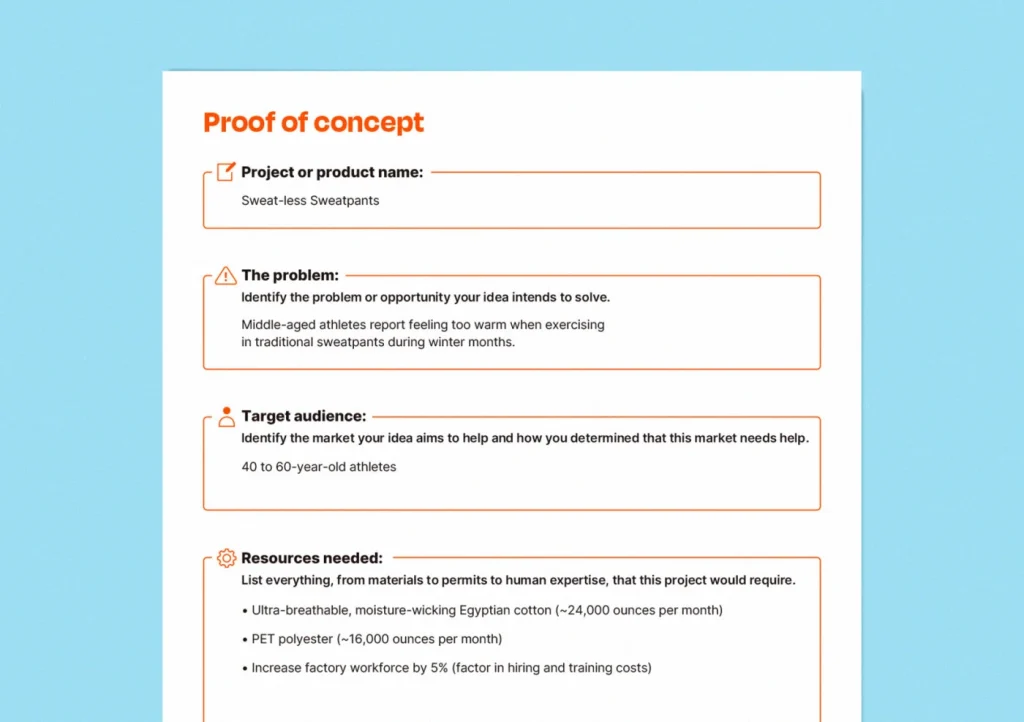
The goal of a POC is not to create a functional, polished product but to demonstrate the concept’s potential and identify any challenges or roadblocks that may arise. You can use POC to validate a product or feature idea before committing significant resources toward development.
What will you get with POC?
POC provides several benefits that help you determine if your idea is worth pursuing:
- Test the viability of an idea or concept and validate its feasibility before investing for a full-scale project
- Identify potential roadblocks early in the development process, which can save time and money.
- Communicate your ideas more effectively than just explaining them with words.
- Reduce development risk by helping you identify what technology will work best with your POC
What is a prototype?
The basics
A prototype is a close replica of what the result of a product will look like, usually without code. Instead of focusing on features and functions, prototype mainly contains UI design and interface interaction (button, CTA, scroll) that the finished product will have. Prototypes are the ultimate designer’s best friend.
It’s also a communication tool between designers and developers. Designer expresses ideas through prototypes, and developer understands what they need to do. Thanks to this, they can work together to identify any required improvements.
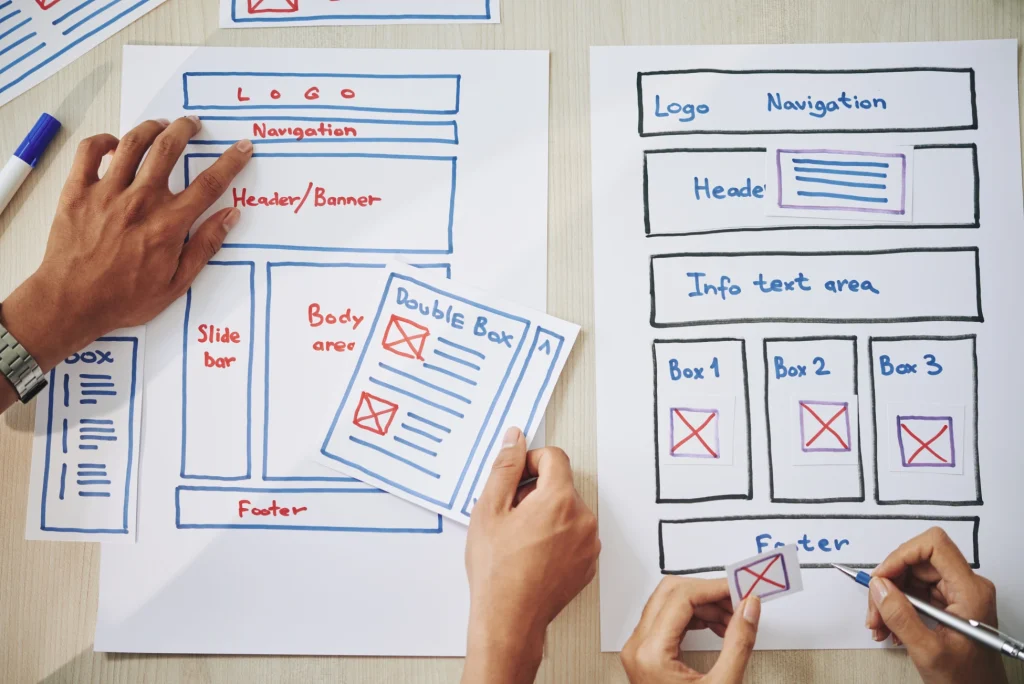
The prototype can be of various types:
- Low-fidelity prototypes are basic sketches or wireframes.
- High-fidelity prototypes are detailed and fully functional models.
- Clickable prototypes are interactive models that allow users to navigate through the software product.
- Non-functional prototypes simulate the look and feel of the final product without the actual functionality.
What will you get with prototype?
When you create a prototype, you can expect to get a visual representation of your idea, which is beneficial because it:
- Visualize your idea to get a better understanding of the details.
- Identify design flaws and usability issues early in the design process.
- Test and refine your design ideas before committing to a final design.
- Communicate your design ideas more effectively.
What is a MVP?
The basics
A Minimum Viable Product, or MVP, is a working version of your product with just enough features to attract early customers and gain feedback for future development. The main goal of an MVP is to test your product idea in the real world and validate whether it’s worth investing more resources into.
In essence, an MVP is the simplest possible version of your product. The key is to focus on the core features that solve the main problem your product aims to solve.
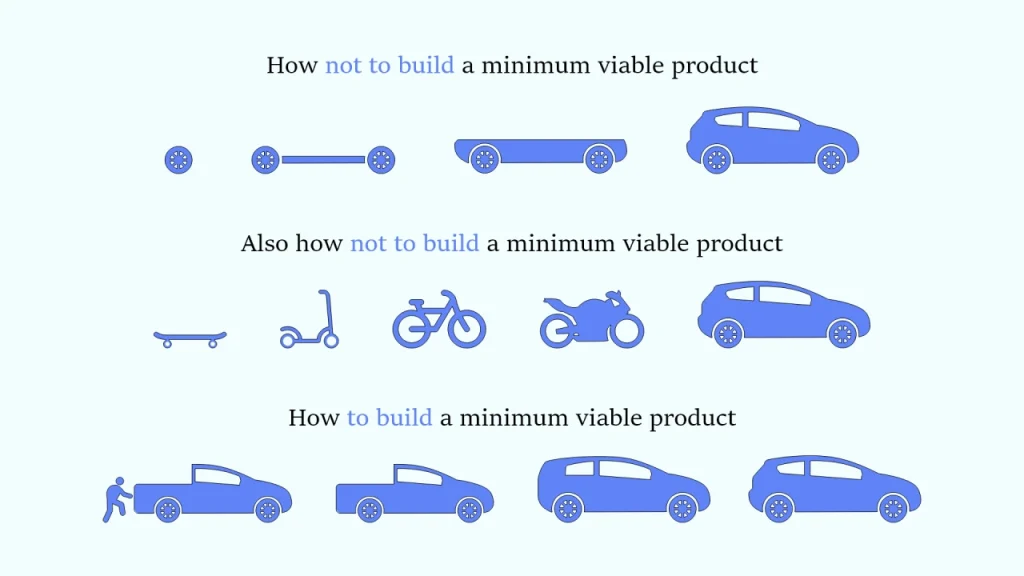
It’s important to note that an MVP is not the final product but a starting point. It’s meant to be improved upon and refined based on user feedback and data analysis.
The concept of MVP can be hard to catch up with. Read our full MVP detailed guide (explain on simple terms) and how these 18 brands build the winning MVP – cases from Dropbox, Spotify, ProductHunt.
What will you get with MVP?
In terms of what you will get with MVP, the answer is:
- Attract investors. Using MVP to make venture capitalists and angel investors interested in your product.
- Save money and time as MVP can determine your business potential quickly.
- Gather valuable feedback to finalize your products.
The difference between POC vs MVP vs prototype
Let’s compare POC vs prototype vs MVP in detail:
| Criteria | POC | Prototype | MVP |
|---|---|---|---|
| Form of Implementation | A simplified version that tests the core idea and feasibility of a concept | A working model that simulates the main functions and features of a product | A complete product with basic features that can be launched in the market |
| What is it | It can be a product analysis document | Wireframe, a simple sketch, a prototype on Figma with basic functions (button, scroll) | The first version of your product |
| Target Audience | Internal teams or early investors. | Internal teams, developer, investors | Early adopters, investors, end-users |
| Cost Effective | Lower cost as it only focuses on the concept and doesn’t require a complete product | Higher cost than POC as it requires a simple working model | Highest cost as it builds a functional application |
| Technical Resources | Minimal technical resources | Requires more technical resources than POC. Mostly designers | Most technical resources. Requires both designers, developers and testers. |
| Risk | Lower risk. You can drop the idea quickly | High risk | Highest risk. If the product doesn’t work out, you waste time and money on a longer development process |
| User Interaction | No user interaction | Minimal to average user interaction | Highest level of user interaction |
| Result | A proof that the concept is feasible and can be developed into a product | A working model to show how the final product will look and function | A full-fledged product with enough features to launch in the market |
| Construction Time | 1 day to 2 weeks | 1 week to 1 month | 4 weeks to 4 months, depending on the complexity |
| Price | Low | Low | High |
| Testing and Feedback | Limited | Extensive | Comprehensive |
| Scalability | Not a priority | Medium | High |
| Focus on Functionality | No | Yes | Yes |
| User Feedback Integration | No | Yes | Yes |
| Measurable Metrics | No | Yes | Yes |
| Flexibility | Low | Medium | High |
| Difference between POC and Prototype | Validates the feasibility of turning a concept into a tangible product. The only possible responses are yes or no | When a PoC has been proven successful, the next step is to create a product prototype. It illustrates how the application’s components interact with one another | |
| Difference between MVP and Prototype | To get feedback from key players on the overall design of the app, a prototype is first created | An MVP is a fully functional version of a product that is released to the public without any further development or testing | |
| Difference between MVP and POC | The novel capabilities are put into place to determine whether the execution is feasible | A version of a product that can be released to the market and which has the core elements necessary for success |
When to choose what?
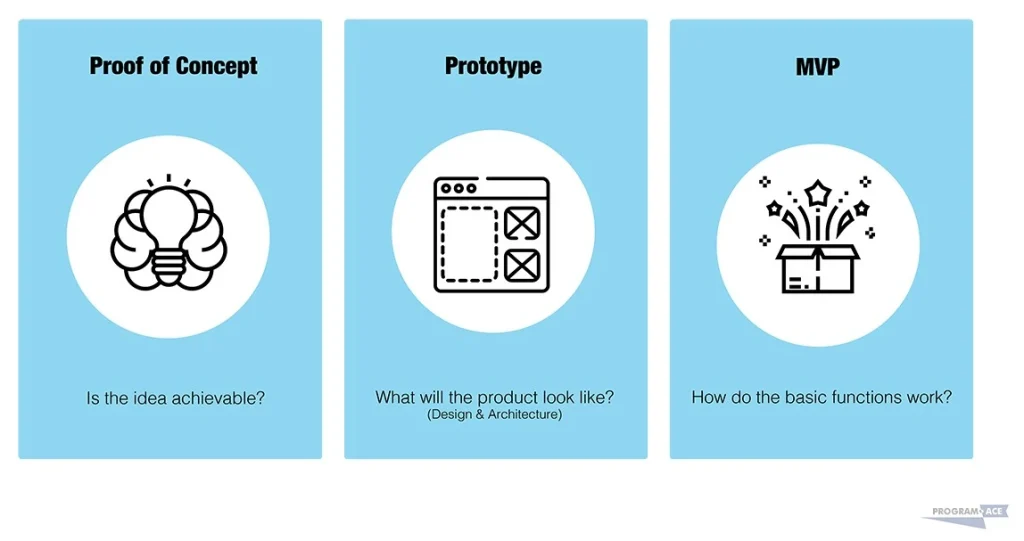
When choosing between POC vs MVP vs Prototype, the decision will largely depend on the goals of the project, the available resources, and the stage of development. Here are some guidelines on when to choose what:
When to choose proof of concept (POC)?
- Your idea is in its infancy.
- You have some uncertainties about your idea.
- Gain investors buy-in or pitch the idea to stakeholders.
- Identify technical requirements and guide decision-making before the development.
When to choose prototype?
- Testing and refining user experience are needed.
- Simulate user experience and test product usability.
- Validate design choices and identify potential user pain points.
- Identify technical limitations and guide product development.
When to choose minimum viable product (MVP)?
- Core features of the product have been identified.
- Need to test in the real world.
- Functional and able to deliver value to the end-user.
- Essential for getting early user feedback and validating assumptions.
- Helpful for gaining traction and generating interest in the product.
POC vs MVP vs Prototype: Different but related
There are many differences between the three approaches. But it doesn’t mean it should be used dependently. In fact, you can use POC or prototype or MVP to support each other during your full-stack product development.
Here’s how to leverage the best of all worlds.
First, test how your software will be technically developed and implemented with a POC. Without this, it’s like you are betting on your tech product.
Then use a prototype to draw out your application’s interface and user journey. With this, you have base guidance for the development process: what interface to create first and how they will link with each other.
After having the POC and Prototype, you can move on to your MVP. To attract early investors, you can use a POC or MVP. But to attract first users, we recommend an MVP is better. Of course, some million-dollar products got their first sign-ups without an actual product, but that’s like 1 in a million. It’s up to you to risk it or not.
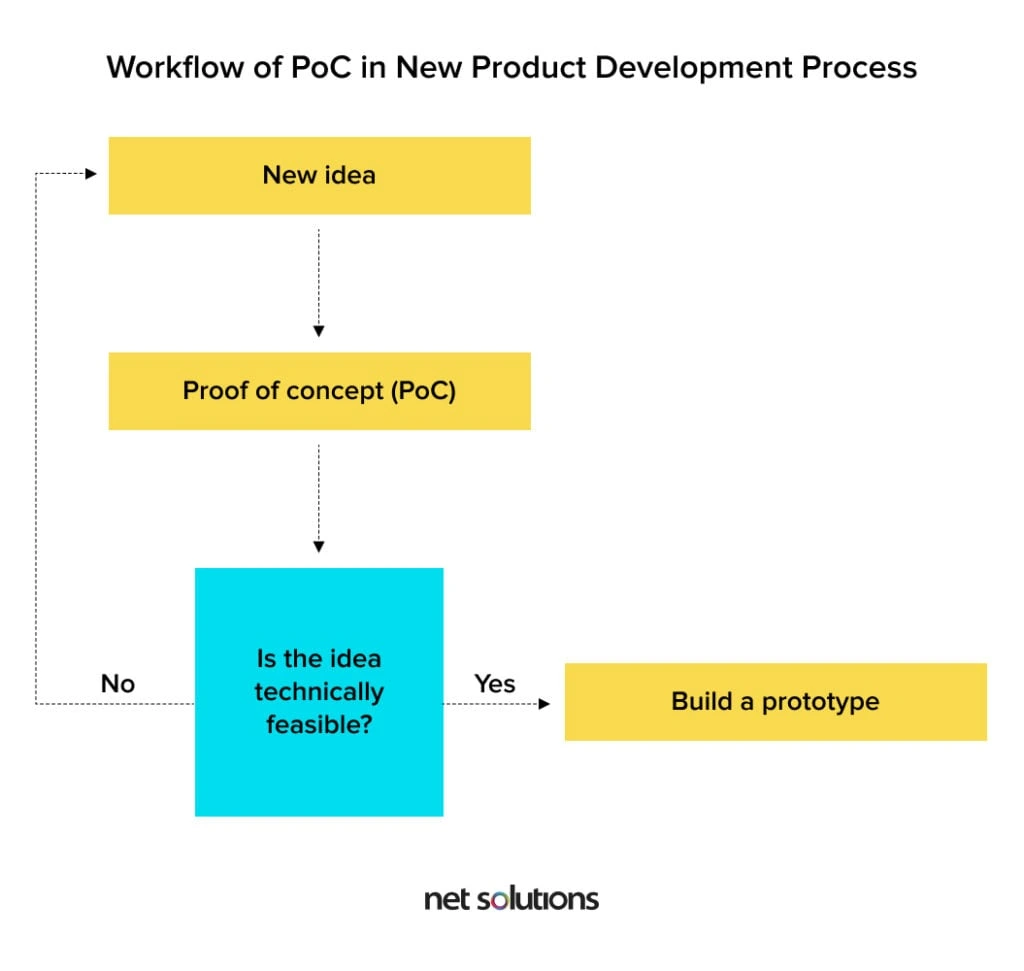
Using the three together will give you a better understanding of your users and products and build a solid one for your first launch. Start with a POC to test your idea technically, then a prototype for its aesthetic and user journey, and last with an MVP that combines POC and prototype results.
Working with many software development projects, Synodus have never seen one being made without a POC and prototype. It’s ridiculous to make an application without knowing what it will look like.
Because of this, we have worked with many startups and enterprises from the first step. We consult you on your POC, help you create a prototype and develop an MVP based on your original ideas and requirements.
This ensures seamless product development and a strategic plan that leads to a desired result (not a mess with fog of tech). View our portfolio!
FAQ
Not necessarily. A POC or prototype primarily aims to demonstrate an idea’s viability. This can be done through visual models, wireframes, and storyboards, which can be created using various prototyping tools without coding.
On the other hand, MVPs typically require some coding to build a functioning product that can be tested in the market. Bot you can use Low code/ no code technology to rapidly develop and launch your idea!
Launching an MVP rather than a prototype allows a business to test its product in the market, gather user feedback, and iterate on the product based on that feedback.
This helps minimize the risk of building a product nobody wants or needs. Moreover, MVPs can help businesses save time and resources by focusing only on the essential features needed for early adopters. Therefore, while prototypes are helpful for internal development, launching an MVP is much better
Wrapping up
Understanding the differences between POC vs MVP vs Prototype is crucial for any product development process. While POC is mainly used to test the feasibility of a concept, MVP focuses on building a functional product that solves a specific problem for a target audience. Prototype, on the other hand, is used to validate design concepts and ideas before building a functional product. By choosing the right approach at the right time, businesses can save time, money, and resources while producing products that meet the needs of their customers.
How useful was this post?
Click on a star to rate it!
Average rating / 5. Vote count:
No votes so far! Be the first to rate this post.




